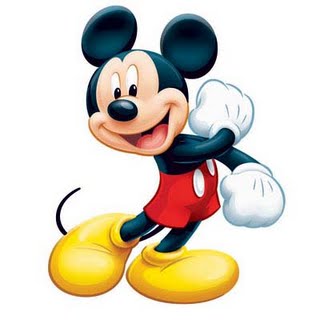





Mickey Mouse is a funny animal cartoon character and the official mascot of The Walt Disney Company. He was created by Walt Disney and Ub Iwerks at the
Walt Disney Studios
in 1928. An anthropomorphic mouse who typically wears red shorts, large yellow shoes, and white gloves, Mickey has become one of the world's most recognizable characters.
Mickey first was seen in a single test screening (Plane Crazy). Mickey officially debuted in the short film Steamboat Willie (1928), one of the first sound
cartoons. He
went on to appear in over 130 films, including The Band Concert (1935), Brave Little Tailor (1938), and Fantasia (1940). Mickey appeared
primarily in short films, but
also occasionally in feature-length films. Ten of Mickey's cartoons were nominated for the Academy Award for Best Animated Short
Film, one of which, Lend a Paw, won
the award in 1942. In 1978, Mickey became the first cartoon character to have a star on the Hollywood Walk of Fame.
Beginning in 1930, Mickey has also been featured extensively as a comic strip character. His self-titled newspaper strip, drawn primarily by Floyd Gottfredson,
ran for
45 years. Mickey has also appeared in comic books and in television series such as The Mickey Mouse Club (1955–1996) and others. He also appears in
other media such as
video games as well as merchandising, and is a meetable character at the Disney parks.
Mickey generally appears alongside his girlfriend Minnie Mouse, his pet dog Pluto, his friends Donald Duck, and Goofy, and his nemesis Pete, among others (see
Mickey Mouse
universe). Though originally characterized as a mischievous antihero, Mickey was rebranded over time as an everyman, usually seen as a flawed,
but adventurous hero.
In 2009, Disney began to rebrand the character again by putting less emphasis on his pleasant, cheerful side and reintroducing the more
mischievous and adventurous
sides of his personality, beginning with the video game Epic Mickey.
Throughout the earlier years, Mickey's design bore heavy resemblance to Oswald, save for the ears, nose and tail. Ub Iwerks designed Mickey's body out of circles in order to make the character simple to animate. Disney employees John Hench and Marc Davis believed that this design was part of Mickey's success as it made him more dynamic and appealing to audiences. Mickey's circular design is most noticeable in his ears, which in traditional animation, always appear circular no matter which way Mickey faces. This made Mickey easily recognizable to audiences and made his ears an unofficial personal trademark. Even today, the rudimentary symbol Mickey Mouse is often used to represent Mickey. This later created a dilemma for toy creators who had to recreate a three-dimensional Mickey. In animation in the 1940s Mickey's ears were animated in a more realistic perspective.